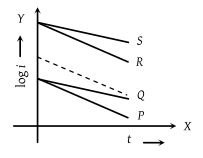During charging a capacitor, the variation of potential V of the capacitor with time t is shown as :
1. 
2. 
3. 
4. 




Three identical capacitors are given a charge Q each and they are then allowed to discharge through resistance R1, R2 and R3. Their charges, as a function of time shown in the graph below. The smallest of the three resistance is
(1) R3
(2) R2
(3) R1
(4) Cannot be predicted
In an RC circuit while discharging, the graph of log i versus time is as shown by the dotted line in the diagram figure, where i is the current. When the value of the resistance is doubled, which of the solid curve best represents the variation of log i versus time ?
(1) P
(2) Q
(3) R
(4) S
A 4 μF capacitor and a resistance of 2.5 MΩ are in series with a 12 V battery. The time after which the potential difference across the capacitor is 3 times the potential difference across the resistor is: [Given ln(2)= 0.693]
1. 13.86 s
2. 6.93 s
3. 7 s
4. 14 s
The plates of a capacitor are charged to a potential difference of 320 volts and are then connected across a resistor. The potential difference across the capacitor decays exponentially with time. After 1 second the potential difference between the plates of the capacitor is 240 volts, then after 2 and 3 seconds the potential difference between the plates will be
(1) 200 and 180 V
(2) 180 and 135 V
(3) 160 and 80 V
(4) 140 and 20 V
In the given figure each plate of capacitance C has partial value of charge equal to:
1. CE
2.
3.
4.
In the figure below, what is the potential difference between the point A and B and between B and C respectively in steady state
(1)
(2)
(3)
(4)
In the circuit here, the steady state voltage across capacitor C is a fraction of the battery e.m.f. The fraction is decided by
1. R1 only
2. R1 and R2 only
3. R1 and R3 only
4. R1, R2 and R3
A capacitor of capacitance 5 μF is connected as shown in the figure. The internal resistance of the cell is 0.5 Ω. The amount of charge on the capacitor plate is?
1. 0 μC
2. 5 μC
3. 10 μC
4. 25 μC
In the figure a long uniform potentiometer wire AB is having a constant potential gradient along its length. The null points for the two primary cells of emfs E1 and E2 connected in the manner shown are obtained at a distance of 120 cm and 300 cm from the end A. Find (i) and position of null point for the cell E1.
How is the sensitivity of a potentiometer increased ?

Using Kirchoffs rules determine the value of unknown resistance R in the circuit so that no current flows through 4 Ω resistance. Also find the potential difference between A and D.







